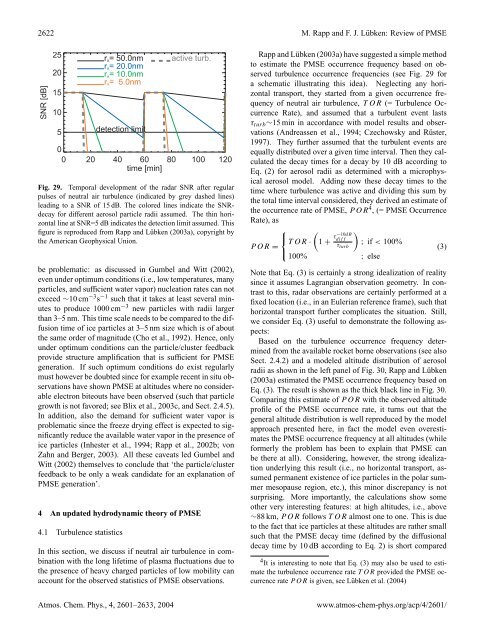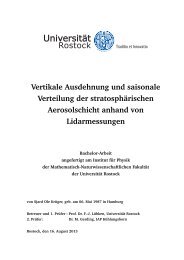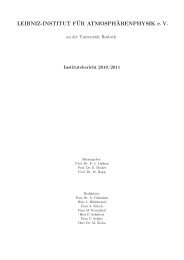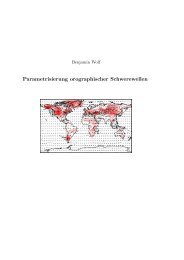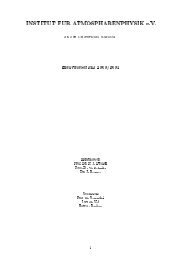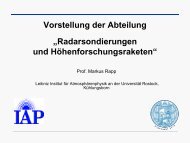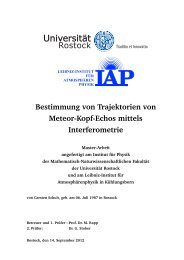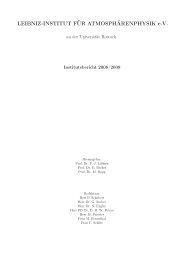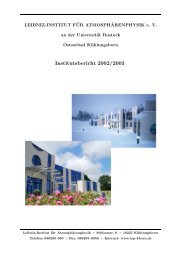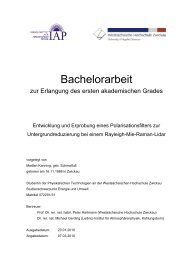Polar mesosphere summer echoes (PMSE): review of ... - HAL
Polar mesosphere summer echoes (PMSE): review of ... - HAL
Polar mesosphere summer echoes (PMSE): review of ... - HAL
You also want an ePaper? Increase the reach of your titles
YUMPU automatically turns print PDFs into web optimized ePapers that Google loves.
2622 M. Rapp and F. J. Lübken: Review <strong>of</strong> <strong>PMSE</strong><br />
Fig. 29. Temporal development <strong>of</strong> the radar SNR after regular<br />
pulses <strong>of</strong> neutral air turbulence (indicated by grey dashed lines)<br />
leading to a SNR <strong>of</strong> 15 dB. The colored lines indicate the SNRdecay<br />
for different aerosol particle radii assumed. The thin horizontal<br />
line at SNR=5 dB indicates the detection limit assumed. This<br />
figure is reproduced from Rapp and Lübken (2003a), copyright by<br />
the American Geophysical Union.<br />
be problematic: as discussed in Gumbel and Witt (2002),<br />
even under optimum conditions (i.e., low temperatures, many<br />
particles, and sufficient water vapor) nucleation rates can not<br />
exceed ∼10 cm −3 s −1 such that it takes at least several minutes<br />
to produce 1000 cm −3 new particles with radii larger<br />
than 3–5 nm. This time scale needs to be compared to the diffusion<br />
time <strong>of</strong> ice particles at 3–5 nm size which is <strong>of</strong> about<br />
the same order <strong>of</strong> magnitude (Cho et al., 1992). Hence, only<br />
under optimum conditions can the particle/cluster feedback<br />
provide structure amplification that is sufficient for <strong>PMSE</strong><br />
generation. If such optimum conditions do exist regularly<br />
must however be doubted since for example recent in situ observations<br />
have shown <strong>PMSE</strong> at altitudes where no considerable<br />
electron biteouts have been observed (such that particle<br />
growth is not favored; see Blix et al., 2003c, and Sect. 2.4.5).<br />
In addition, also the demand for sufficient water vapor is<br />
problematic since the freeze drying effect is expected to significantly<br />
reduce the available water vapor in the presence <strong>of</strong><br />
ice particles (Inhester et al., 1994; Rapp et al., 2002b; von<br />
Zahn and Berger, 2003). All these caveats led Gumbel and<br />
Witt (2002) themselves to conclude that ‘the particle/cluster<br />
feedback to be only a weak candidate for an explanation <strong>of</strong><br />
<strong>PMSE</strong> generation’.<br />
4 An updated hydrodynamic theory <strong>of</strong> <strong>PMSE</strong><br />
4.1 Turbulence statistics<br />
In this section, we discuss if neutral air turbulence in combination<br />
with the long lifetime <strong>of</strong> plasma fluctuations due to<br />
the presence <strong>of</strong> heavy charged particles <strong>of</strong> low mobility can<br />
account for the observed statistics <strong>of</strong> <strong>PMSE</strong> observations.<br />
Rapp and Lübken (2003a) have suggested a simple method<br />
to estimate the <strong>PMSE</strong> occurrence frequency based on observed<br />
turbulence occurrence frequencies (see Fig. 29 for<br />
a schematic illustrating this idea). Neglecting any horizontal<br />
transport, they started from a given occurrence frequency<br />
<strong>of</strong> neutral air turbulence, T OR (= Turbulence Occurrence<br />
Rate), and assumed that a turbulent event lasts<br />
τ turb ∼15 min in accordance with model results and observations<br />
(Andreassen et al., 1994; Czechowsky and Rüster,<br />
1997). They further assumed that the turbulent events are<br />
equally distributed over a given time interval. Then they calculated<br />
the decay times for a decay by 10 dB according to<br />
Eq. (2) for aerosol radii as determined with a microphysical<br />
aerosol model. Adding now these decay times to the<br />
time where turbulence was active and dividing this sum by<br />
the total time interval considered, they derived an estimate <strong>of</strong><br />
the occurrence rate <strong>of</strong> <strong>PMSE</strong>, P OR 4 , (= <strong>PMSE</strong> Occurrence<br />
Rate), as<br />
⎧<br />
)<br />
⎨<br />
T OR ·<br />
(1 + τ diff<br />
−10dB<br />
P OR =<br />
τ turb<br />
; if < 100%<br />
(3)<br />
⎩<br />
100% ; else<br />
Note that Eq. (3) is certainly a strong idealization <strong>of</strong> reality<br />
since it assumes Lagrangian observation geometry. In contrast<br />
to this, radar observations are certainly performed at a<br />
fixed location (i.e., in an Eulerian reference frame), such that<br />
horizontal transport further complicates the situation. Still,<br />
we consider Eq. (3) useful to demonstrate the following aspects:<br />
Based on the turbulence occurrence frequency determined<br />
from the available rocket borne observations (see also<br />
Sect. 2.4.2) and a modeled altitude distribution <strong>of</strong> aerosol<br />
radii as shown in the left panel <strong>of</strong> Fig. 30, Rapp and Lübken<br />
(2003a) estimated the <strong>PMSE</strong> occurrence frequency based on<br />
Eq. (3). The result is shown as the thick black line in Fig. 30.<br />
Comparing this estimate <strong>of</strong> P OR with the observed altitude<br />
pr<strong>of</strong>ile <strong>of</strong> the <strong>PMSE</strong> occurrence rate, it turns out that the<br />
general altitude distribution is well reproduced by the model<br />
approach presented here, in fact the model even overestimates<br />
the <strong>PMSE</strong> occurrence frequency at all altitudes (while<br />
formerly the problem has been to explain that <strong>PMSE</strong> can<br />
be there at all). Considering, however, the strong idealization<br />
underlying this result (i.e., no horizontal transport, assumed<br />
permanent existence <strong>of</strong> ice particles in the polar <strong>summer</strong><br />
mesopause region, etc.), this minor discrepancy is not<br />
surprising. More importantly, the calculations show some<br />
other very interesting features: at high altitudes, i.e., above<br />
∼88 km, P OR follows T OR almost one to one. This is due<br />
to the fact that ice particles at these altitudes are rather small<br />
such that the <strong>PMSE</strong> decay time (defined by the diffusional<br />
decay time by 10 dB according to Eq. 2) is short compared<br />
4 It is interesting to note that Eq. (3) may also be used to estimate<br />
the turbulence occurrence rate T OR provided the <strong>PMSE</strong> occurrence<br />
rate P OR is given, see Lübken et al. (2004)<br />
Atmos. Chem. Phys., 4, 2601–2633, 2004<br />
www.atmos-chem-phys.org/acp/4/2601/


